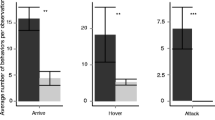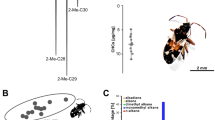Abstract
Various organisms, especially arthropods, are able to live as parasites in ant nests and to prey upon ant broods without eliciting any aggressive behaviour in the hosts. Understanding how these intruders are able to break the ants’ communication codes in their favour represents a challenging and intriguing evolutionary question. We studied the chemical strategies of three European hoverfly species, Microdon mutabilis (parasitic on Formica cunicularia), M. analis (parasitic on Lasius emarginatus) and M. devius (parasitic on L. distinguendus). The peculiar slug-like larvae of these three species live inside ant nests feeding upon their broods. Gas chromatography-mass spectrometry analyses show that: 1) these parasites mimic the host brood rather than the ant workers, although each differs distinctly in the extent of chemical mimicry; 2) isolation experiments indicate that after 14 days the responsible cuticular hydrocarbons (CHCs) are not passively acquired but synthesized by the fly larvae. Additionally, Microdon larvae show an array of protective structural features, such as a thick and multi-layered cuticle, retractable head, dome-shaped tergum and a flat and strongly adhesive “foot” (sternum). This combination of protective chemical and structural features represents a successful key innovation by Microdon species, and one that may facilitate host switching. The results of a preliminary adoption analysis confirm that Microdon larvae of at least some species can readily be accepted by different species of ants.



Similar content being viewed by others
References
Akino T (2006) Cuticular hydrocarbons of Formica truncorum (Hymenoptera: Formicidae): description of new very long chained hydrocarbon components. Appl Entomol Zool 41:667–677
Akino T, Knapp JJ, Thomas JA, Elmes GW (1999) Chemical mimicry and host specificity in the butterfly Maculinea rebeli, a social parasite of Myrmica ant colonies. Proc R Soc Lond B Biol Sci 266:1419–1426
Akre RD, Alpert G, Alpert T (1973) Life cycle and behavior of Microdon cothurnatus in Washington (Diptera: Syrphidae). J Kansas Entomol Soc 46:327–338
Akre RD, Garnett WB, Richard SZ (1988) Biology and behavior of Microdon piperi in the Pacific northwest (Diptera: Syrphidae). J Kansas Entomol Soc 61:441–452
Akre RD, Garnett WB, Richard SZ (1990) Ant hosts of Microdon (Diptera: Syrphidae) in the Pacific northwest. J Kansas Entomol Soc 63:175–117
Andries M (1912) Zur Systematik, Biologie und Entwicklung von Microdon Meigen. Z Wiss Zool 103:300–361
Bagnères AG, Lorenzi C (2010) Chemical deception/mimicry using cuticular hydrocarbons. In: Blomquist GJ, Bagnères AG (eds) Hydrocarbons: biology. Cambridge University Press, Biochemistry and Chemical Ecology Insect, pp 282–324
Barbero F, Bonelli S, Thomas JA, Balletto E, Schönrogge K (2009) Acoustical mimicry in a predatory social parasite of ants. J Exp Biol 212:4084–4090
Barr B (1995) Feeding behaviour and mouthpart structure of larvae of Microdon eggeri and Microdon mutabilis (Diptera, Syrphidae). Dipterists Digest 2:31–36
Bonelli S, Witek M, Canterino S, Sielezniew M, Stankiewicz-Fiedurek A, Tartally A, Balletto E, Schönrogge K (2011) Distribution, host specificity, and the potential for cryptic speciation in hoverfly Microdon myrmicae (Diptera: Syrphidae), a social parasite of Myrmica ants. Ecol Entomol 36:135–143. https://doi.org/10.1111/j.1365-2311.2010.01253.x
Boulay R, Hefetz A, Soroker V, Lenoir A (2000) Camponotus fellah colony integration: worker individuality necessitates frequent hydrocarbons exchanges. Anim Behav 59:1127–1133
Cammaerts R (1995) Regurgitation behaviour of the Lasius flavus worker (Formicidae) towards the myrmecophilous beetle Claviger testaceus (Pselaphidae) and other recipients. Behav Process 34:241–264
Cushing PE (2012) Spider-ant associations: an updated review of Myrmecomorphy, Myrmecophily, and Myrmecophagy in spiders. Psyche. https://doi.org/10.1155/2012/151989
d'Ettorre P, Mondy N, Lenoir A, Errard C (2002) Blending in with the crowd: social parasites integrate into their host colonies using a flexible chemical signature. Proc R Soc Lond [Biol] https://doi.org/10.1098/rspb.2002.2110
Di Giulio A, Maurizi E, Barbero F, Sala M, Fattorini S, Balletto E, Bonelli S (2015) The pied Piper: a parasitic Beetle’s melodies modulate ant Behaviours. PLoS One 10:e0130541. https://doi.org/10.1371/journal.pone.0130541
Doczkal D, Schmid U (1999) Revision of the central European species of the genus Microdon Meigen (Diptera, Syrphidae). Volucella 4:45–68
Donisthorpe HJK (1927) The guests of british ants - their habits and life-histories. George Routledge and Sons Ltd, London
Duffield RM (1981) Biology of Microdon fuscipennis (Diptera : Syrphidae) with interprétations of the reproductive strategies of Microdon specied found north of Mexico. Proc Entomol Soc Wash 83:716–724
Elmes GW, Barr B, Thomas JA, Clarke RT (1999) Extreme host specificity by Microdon mutabilis (Diptera: Syrphidae), a social parasite of ants. Proc R Soc Lond B 266:447–453
Errard C, Le Guisquet AM, Christidès JP, Mercier JL, Lenoir A, Hefetz A (2008) Early learning of volatile chemical cues leads to interspecific recognition between two ant species. Insect Soc 55:115–122
Garnett WB, Akre RD, Sehlke G (1985) Cocoon mimicry and predation of myrmecophilous Diptera (Diptera:Syrphidae). Fla Entomol 68:615–621
Garnett WB, Akre RD, Zack RS (1990) External morphology of four species of Microdon Immatures (Diptera: Syrphidae) from the Pacific northwest. Ann Entomol Soc Am 83:68–80
Gibbs A (2002) Lipid melting and cuticular permeability: new insights into an old problem. J Insect Physiol 48:391–400
Ginzel MD, Blomquist GJ (2016) Insect hydrocarbons: biochemistry and chemical ecology. In: Cohen E, Moussian B (eds) Extracellular composite matrices in arthropods. Springer, Cham, pp 221–252
Greene MJ, Gordon DM (2007) Structural complexity of chemical recognition cues affects the perception of group membership in the ants Linephithema humile and Aphaenogaster cockerelli. J Exp Biol 210:897–905. https://doi.org/10.1242/jeb.02706
Hernandez JV, Goitia W, Osio A, Cabrera A, Lopez H, Sainz C, Jaffe K (2006) Leaf-cutter ant species (Hymenoptera: Atta) differ in the type of cues used to differentiate between self and others. Anim Behav 71:945–952
Holldobler B, Wilson EO (1990) The ants. Springer, Berlin
Howard RW, Akre RD, Garnett WB (1990a) Chemical mimicry in an obligate predator of carpenter ants (Hymenoptera: Formicidae). Ann Entomol Soc Am 83:607–616
Howard RW, Stanley-Samuelson DW, Akre RD (1990b) Biosynthesis and chemical mimicry of Cuticular hydrocarbons from the obligate predator, Microdon albicomatus Novak (Diptera: Syrphidae) and its ant prey, Myrmica incompleta Provancher (Hymenoptera: Formicidae). J Kansas Entomol Soc 63:437–443
Kistner DH (1979) Social and evolutionary significance of social insect symbionts. In: Herman H (ed) Social insects, vol 1. Academic, New York, pp 339–413
Lachaud J-P, Lenoir A, Hughes DP (2013) Ants and their parasites. Psyche. https://doi.org/10.1155/2013/264279
Lenoir A, d'Ettorre P, Errard C, Hefetz A (2001a) Chemical ecology and social parasitism in ants. Annu Rev Entomol 46:573–599
Lenoir A, Cuisset D, Hefetz A (2001b) Effects of social isolation on hydrocarbon pattern and nestmate recognition in the ant Aphaenogaster senilis (Hymenoptera, Formicidae). Insect Soc 48:101–109
Lockey KH (1988) Lipids of the insect cuticle: origin, composition, and function. Comp Biochem Physiol B 89:595–645
Martin S, Drijfhout F (2009) A review of ant Cuticular hydrocarbons. J Chem Ecol 35:1151–1161
Nash DR, Boomsma JJ (2008) Communication between hosts and social parasites. In: d’Ettorre P, Hughes DP (eds) Sociobiology of communication: an interdisciplinary perspective. Oxford University Press, Oxford, pp 55–80
Nehring V, Dani FR, Calamai L, Turillazzi S, Bohn H, Klass K-D, d’Ettorre P (2016) Chemical disguise of myrmecophilous cockroaches and its implications for understanding nestmate recognition mechanisms in leaf-cutting ants. BMC Ecol 16:35
Parmentier T, Dekoninck W, Wenseleers T (2017) Arthropods associate with their red wood ant host without matching Nestmate recognition cues. J Chem Ecol 43:644–661
Parmentier T, De Laender F, Wenseleers T, Bonte D (2018) Prudent behavior rather than chemical deception enables a parasite to exploit its ant host. Behav Ecol https://doi.org/10.1093/beheco/ary134
Provost E, Blight O, Tirard A, Renucci M (2008) Hydrocarbons and insects’ social physiology. In: Maes RP (ed) Insect physiology: NewResearch. Nova Science Publishers, Hauppauge, pp 19–72
Reemer M, Stahls G (2013) Phylogenetic relationships of Microdontinae (Diptera: Syrphidae) based on molecular and morphological characters. Syst Entomol 38:661–688
Remeer M (2013) Review and phylogenetic evaluation of associations between Microdontinae (Diptera: Syrphidae) and ants (Hymenoptera: Formicidae). Psyche. https://doi.org/10.1155/2013/538316
Rotheray G, Gilbert F (1999) Phylogeny of Palaearctic Syrphidae (Diptera): evidence from larval stages. Zool J Linnean Soc 127:1–112
Sala M, Casacci LP, Balletto E, Bonelli S, Barbero F (2014) Variation in butterfly larval acoustics as a strategy to infiltrate and exploit host ant Colony resources. PLoS One 9:e94341. https://doi.org/10.1371/journal.pone.0094341
Scarparo G, Cerretti P, Mei M, Di Giulio A (2017) Detailed morphological descriptions of the immature stages of the ant parasite Microdon mutabilis (Diptera: Syrphidae: Microdontinae) and a discussion of its functional morphology, behaviour and host specificity. Eur J Entomol 114:565–586
Schmid U (2004) Microdon rhenanus and Microdon eggeri var. major (Diptera, Syrphidae) revisited. Volucella 7:111–124
Schönrogge K, Barr B, Wardlaw JC, Napper E, Gardner MG, Breen J, Elmes GW, Thomas JA (2002) When rare species become endangered: cryptic speciation in myrmecophilous hoverflies. Biol J Linn Soc 75:291–300
Schönrogge K, Gardner MG, Elmes GW, Napper EKV, Simcox DJ, Wardlaw JC, Breen J, Barr B, Knapp JJ, Pickett JA, Thomas JA (2006) Host propagation permits extreme local adaptation in a social parasite of ants. Ecol Lett 9:1032–1040
Singer TL (1998) Roles of hydrocarbons in the recognition systems of insects. Am Zool 38:394–405
Speight MCD (2004) Fauna Europaea: Syrphidae. In Fauna Europaea: Diptera, Brachycera. In: Pape T (ed) Fauna Europaea. http://www.faunaeur.org. Accessed 26 June 2017
Speight MCD (2017) Species accounts of European Syrphidae. Syrph the net, the database of European Syrphidae (Diptera). Syrph the net publications, Dublin
Thomas JA, Schönrogge K, Elmes GW (2005) Specializations and host associations of social parasites of ants. In: Fellowes MDE, Holloway GJ, Rolff J (eds) Insect evolutionary ecology. CABI, Wallingford, pp 479–518
van Zweden JS, d'Ettorre P (2010) The role of hydrocarbons in nestmate recognition. In: Blomquist G, Bagnères AG (eds) Insect hydrocarbons: biology. Biochemistry and Chemical Ecology. Cambridge University Press, Cambridge, pp 222–243
von Beeren C, Brückner A, Maruyama M, Burke G, Wieschollek J, Kronauer DJC (2018) Chemical and behavioral integration of army ant-associated rove beetles – a comparison between specialists and generalists. Front Zool 15:8
Wilson EO (1971) The insect societies. Harvard University Press, Cambridge
Witek M, Casacci LP, Barbero F, Patricelli D, Sala M, Bossi S, Maffei M, Woyciechowski M, Balletto E, Bonelli S (2013) Interspecific relationships in co-occurring populations of social parasites and their host ants. Biol J Linn Soc 109:699–709
Wolton R (2011) Observations on ecology and behaviour of Microdon myrmicae Schönrogge et al. (Diptera, Syrphidae), with a description of egg and early instar morphology. Dipterists Digest 18:55–67
Acknowledgments
We are indebted to our friend Robert Wolton (UK) for the English revision of the text and for his precious comments and suggestions that widely improved the manuscript. We are very grateful to our colleagues Marco Molfini, Luigi Cao Pinna and Francesco Simone Mensa for their help during the field sampling and Chloé Leroy for her support during gas chromatography-mass spectrometry analysis. Electron microscopy analyses were done at L.I.M.E. (Laboratorio Interdipartimentale Microscopia Elettronica) of University of Roma Tre and funded by Department of Science Research Grants (CAL Di Giulio 2017) and the Grant of Excellence Departments, MIUR-Italy (ARTICOLO 1, COMMI 314 – 337 LEGGE 232/2016). P. d’Ettorre was funded by the French National Research Agency (ANR-14-CE18-0003, PHEROMOD). We are grateful to two anonymous referees for their useful suggestions.
Author information
Authors and Affiliations
Corresponding author
Rights and permissions
About this article
Cite this article
Scarparo, G., d’Ettorre, P. & Di Giulio, A. Chemical Deception and Structural Adaptation in Microdon (Diptera, Syrphidae, Microdontinae), a Genus of Hoverflies Parasitic on Social Insects. J Chem Ecol 45, 959–971 (2019). https://doi.org/10.1007/s10886-019-01121-0
Received:
Revised:
Accepted:
Published:
Issue Date:
DOI: https://doi.org/10.1007/s10886-019-01121-0




